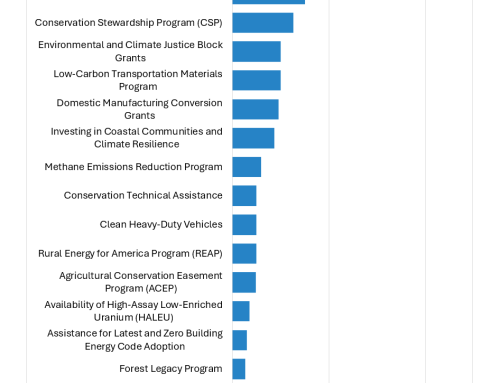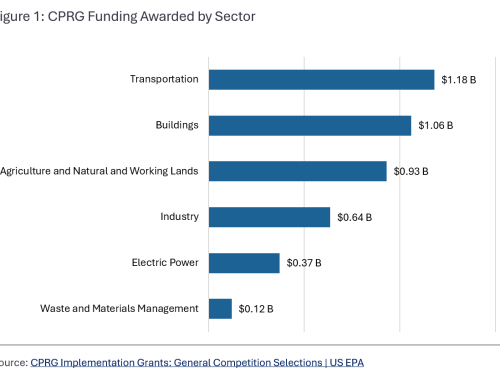
We are coming up on the first anniversary of the launch of the Climate Program Portal (CPP) Outcomes Dashboard. This tool tracks awarded funding from climate programs in the Infrastructure Investment and Jobs Act (IIJA) and the Inflation Reduction Act (IRA). In this month’s spotlight, we will highlight five key climate programs that have awarded funding since IIJA and IRA’s passages. These five competitive grant programs have some of the largest funding awarded by their respective climate elements, which we assign to projects based on the strategies they include to address climate change. To view a summary of other key programs, you can read a Spotlight we previously published here.
Active Transportation: Safe Streets and Roads for All (SS4A)
The Department of Transportation’s (DOT) Safe Streets and Roads for All (SS4A) program provides “supplemental funding to support local initiatives to prevent death and serious injury on roads and streets, commonly referred to as “Vision Zero” or “Toward Zero Deaths” initiatives.” The IIJA appropriates $5 billion over five years for this program. Combining fiscal years (FY) 2022 and 2023 awards, the SS4A program has awarded $1.7 billion for 1,130 projects. More than three quarters of the funding was awarded to local governments. Additionally, most of the funding went to active transportation projects.
For example, the City of Atlanta was awarded $30 million in 2022 to “transform Pryor Street and Central Avenue in Atlanta, Georgia, to safe streets with protected bike and pedestrian facilities, and connect the Southside of Atlanta and the Southside Beltline trail to Atlanta’s downtown.” The project will add new bike lanes, crosswalk lighting, and other safety measures. According to DOT, “there are currently no other built bicycle facilities that run north and south through downtown, so this project would be a major expansion of the current system and bike network.” Over in the Golden State, the City of Lancaster was awarded $19.6 million in 2023 “for multiple Complete Streets improvements on Challenger Way for pedestrians and bicyclists.” Complete streets refers to widening and protecting existing bike lanes, increasing crosswalk visibility, and improving safety for users of a local bus route that runs along the corridor. Much of the funding is going to local governments to build out safety action plans, which could support further action down the line as cities and counties work to reduce danger on the roads.
On February 21, 2024, the DOT opened applications for $1.2 billion through the FY 2024 SS4A grant program. There are multiple application deadlines depending on the grant type. Planning and Demonstration Grant applicants have three deadlines: April 4, 2024, May 16, 2024, and August 29, 2024. Implementation Grant applicants must apply by May 16, 2024. Learn more here.
Transit and Rail: Federal-State Partnerships for Intercity Passenger Rail Grants
The Federal-State Partnerships for Intercity Passenger Rail Grants (FSP) program is a $36 billion competitive grant program administered by the DOT’s Federal Railroad Administration (FRA) and funded by IIJA. This program funds capital projects that reduce the state of good repair backlog, improve performance, or expand or establish new intercity passenger rail services, including those operated privately. Per an IIJA revision, funding is awarded in two categories based on project region: (1) projects located on the Northeast Corridor (FSP-NEC), and (2) projects not located on the Northeast Corridor (FSP-National). This is the largest investment in transit made by IIJA and IRA and the program has issued more awarded funding than any other program.
As of December 2023, the FSP program has awarded a whopping $24.6 billion (or 68 percent of the total funding appropriated), making it the program with the highest funding awarded to date. Of that funding, $16.4 billion went to FSP-NEC projects, and $8.2 billion went to FSP-National projects. The largest FSP-NEC project award went to Amtrack’s B&P Tunnel Replacement Program – Frederick Douglass Tunnel in Maryland. This $4.7 billion project features a new two-track tunnel that will primarily serve electrified passenger trains, new railroad and roadway bridges, and more accessible high-level platforms.
Additionally, the largest FSP-National project award is $3.1 billion for the California High-Speed Rail Authority’s (CHSRA) California Inaugural High-Speed Rail Service Project. This is a segment of the larger California High-Speed Rail project. While most of the projects funded here are maintaining aging infrastructure, California’s high-speed rail project will support a new rail line. The project involves various activities including the final design and right-of-way acquisition for the Merced and Bakersfield extensions; civil, track, and systems construction for the Bakersfield Interim extension; design and construction of the Fresno Station and trainset facilities; and design and procurement of trainsets. The project will help reduce greenhouse gas emissions and improve safety for passengers and affected communities.
The program has a further $9 billion to administer.
Electrification: Clean School Bus Program
The U.S. Environmental Protection Agency (EPA) allocates $5 billion over five years to the Clean School Bus (CSB) Program. There are two programs within this program, including a grant program and a rebate program, to purchase and replace existing school buses with zero-emission and clean school buses. According to the EPA, grant recipients are awarded funds to purchase buses whereas rebate recipients receive awards before purchasing buses.
Nearly $2 billion has been awarded for 452 projects through the CSB Program. It is important to note that CPP’s number differs from the EPA’s – which lists 435 projects – because we crosscheck with data published on the White House’s Invest.gov website. The numbers also may change based on negotiations with school districts. The first batch of awards went to the 2022 CSB Rebate Program.
In October 2022, the EPA announced nearly $1 billion in awards for 389 school districts spanning all 50 states, Washington, DC, and several Tribes and U.S. territories. The funds will be used to purchase over 2,400 clean school buses. The 2022 CSB Rebate awardees were picked through a lottery system while the 2023 CSB Grant Program distributed awards through a competitive process.
In January 2024, the EPA awarded nearly $1 billion to 67 applicants through the 2023 CSB Grant Program. The funds will help purchase over 2,700 clean school buses (95 percent of which will be electric) in 280 school districts serving over seven million students across 37 states. Georgia, Illinois, and Texas were awarded more buses than any other state. Furthermore, about 86 percent of the selected projects are from prioritized school districts in low-income, rural, and/or Tribal communities.
Across both rounds of awards, Illinois has been awarded more funding to date than any other state at $170 million to support 212 buses in the state in 20 school districts. California comes in second with $150 million for 25 projects. Louisiana claims the third spot, securing about $129 million to purchase 177 buses. In Michigan, the School District of the City of Pontiac has received enough funds through the CSB Program such that the whole fleet will be electric.
The EPA noted some challenges with the program, including via a report released by the EPA’s Office of Inspector General in December 2023. According to the report, a lack of charging stations could delay the rollout of the program.
In Fall 2023, EPA opened the 2023 CSB Rebate program and expects to award at least $500 million in funding. Rebate applications were due by February 14, 2024. Award announcements are expected in April 2024.
Resilience: Grid Resilience and Innovation Partnerships (GRIP) Program
The Department of Energy (DOE) Grid Deployment Office (GDO) received $10.5 billion from IIJA for three programs under the Grid Resilience and Innovation Partnerships (GRIP) Program. This includes $5 billion for the Grid Innovation Program, $2.5 billion for the Preventing Outages and Enhancing the Resilience of the Electric Grid Competitive Grants, and $3 billion for the Smart Grid Grants. The goal of GRIP is to “enhance grid flexibility and improve the resilience of the power system against growing threats of extreme weather and climate change.”
On October 18, 2023, the DOE announced $3.46 billion in awards for 58 projects through round one of the GRIP program. To break it down even further, $1.44 billion went to eight projects selected under the Grid Innovation Program, $919 million went to 16 projects selected under the Preventing Outages and Enhancing the Resilience of the Electric Grid Competitive Grants, and $1.1 billion went to 34 projects selected under the Smart Grid Grants.
The largest award went to the Minnesota Department of Commerce at $464 million for the Joint Targeted Interconnection Queue Transmission Study Process and Portfolio. This will plan, design, and construct five transmission projects across seven Midwest states including Iowa, Kansas, Nebraska, North Dakota, Minnesota, Missouri, and South Dakota. The project is expected to unlock 30 gigawatts of new generation, primarily wind and solar energy. The project also provides numerous benefits, most notably, targeted training and workforce development for disadvantaged communities.
Only one Tribal government was awarded funding in this round – the Confederated Tribes of Warm Springs Reservation of Oregon (CTWS). In partnership with Portland General Electric (PGE), CTWS received $250 million to upgrade transmission capacity by connecting PGE’s load centers with the currently isolated renewable generation resources east of the Cascades, including those on the Warm Springs Reservation.
On November 14, 2023, the DOE announced up to $3.9 billion is available through the second funding round of the GRIP Program for FYs 2024 and 2025. Applications are due April 17, 2024. After this round, about $3 billion will be left, or 31 percent of total funding remaining. Learn more here.
Hydrogen: Regional Clean Hydrogen Hubs
The Regional Clean Hydrogen Hubs is part of a larger $8 billion clean hydrogen hub program administered by the DOE. The program’s goal is “to support the development of at least four regional clean hydrogen hubs to improve clean hydrogen production, processing, delivery, storage, and end use.”
On October 13, 2023, the DOE announced it had awarded $7 billion to seven regional clean hydrogen hubs to support the production of clean hydrogen for hard to decarbonize industrial sectors. Together, the hubs are expected to produce more than three million metric tons of hydrogen annually and reduce 25 million metric tons of carbon dioxide emissions from end uses each year. The hubs are also expected to create 334,280 construction and permanent jobs, supporting both jobs and emissions reductions. However, environmental groups like the Union of Concerned Scientists and the National Resource Defense Council have raised concerns about the emissions impacts of the four hubs using fossil fuels to produce hydrogen. Namely, generating hydrogen ‘cleanly’ relies on the assumption that nearly all of the produced carbon dioxide is captured, an assumption that may be overly optimistic.
Another emerging tension on the hubs relates to eligibility for the Clean Hydrogen Tax Credit (45V). In February, the seven hubs submitted a joint filing on Treasury’s proposed rules for the tax credit arguing their projects would no longer be “economically viable” under the proposed rules. The rules would require projects to pass a “three part test” regarding their power source.
Continue to follow the developments of these and hundreds of other IIJA and IRA programs on our Outcomes Dashboard. Look out for Part Two in our Outcomes Dashboard update in April where we’ll provide an overview of climate investments by state.


